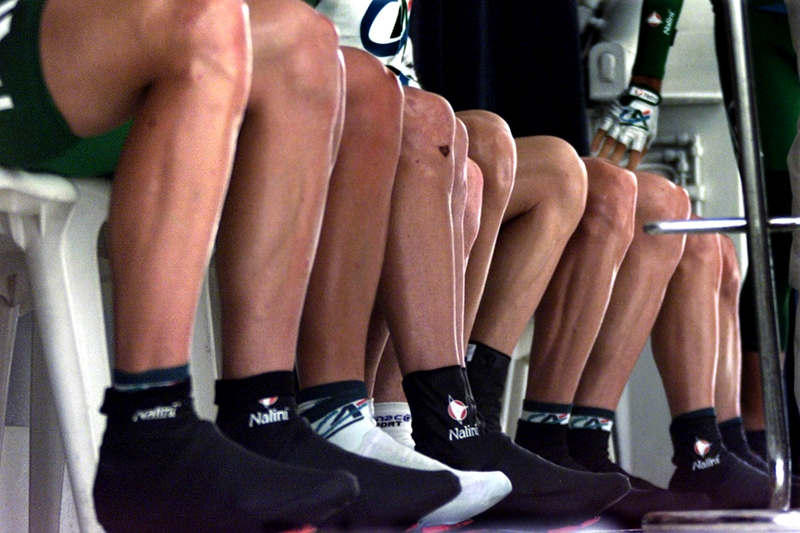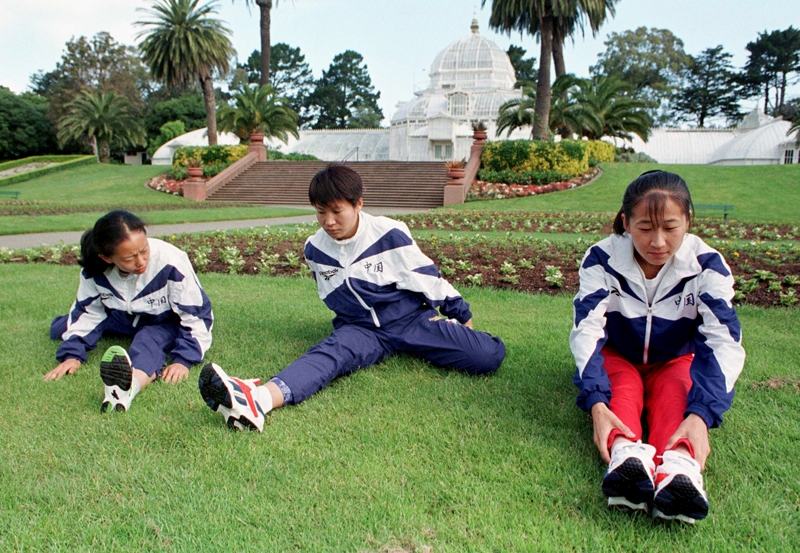You are viewing 1 of your 1 free articles. For unlimited access take a risk-free trial
Runner, cyclist, triathlete: who’s the most efficient on the move?
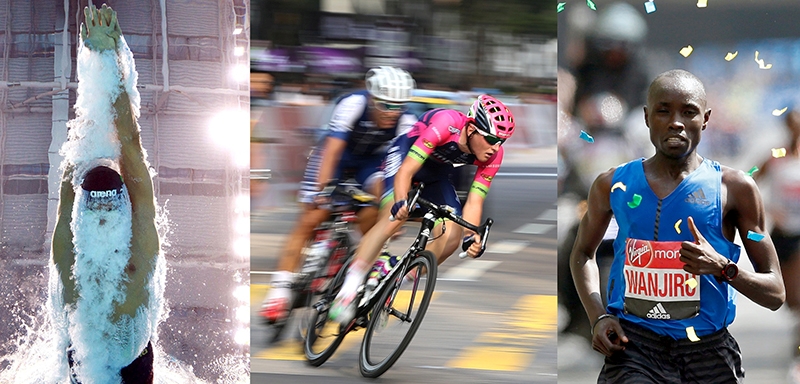
Andrew Hamilton looks at new research on muscle efficiency in runners, cyclists and triathletes, and the possible implications for triathlon training programmes
In years gone by, the main yardstick of endurance performance was maximum aerobic capacity – more technically known as ‘VO2max’ (measured in millilitres of oxygen per kilo of bodyweight per minute – ml/kg/min). The reason is simple; over long-distance events, nearly all the energy for muscle movement is derived by burning carbohydrate (glycogen) and fat in the presence of oxygen. But while the human body can store plenty of fat, and quite a bit of carbohydrate, oxygen storage capacity is virtually nil. That means the amount of oxygen available to exercising muscles is determined by the body’s ability to absorb, transport and deliver oxygen to those muscles.However, over the past thirty years or so, evidence has accumulated indicating that a much better measure (than VO2max) of an individual’s aptitude for success in endurance events is something called maximal lactate steady state –or MLSS for short(1,2). This measure is the maximum workload that the body can sustain without the accumulation of (fatiguing) lactate in the bloodstream(3).
Although it might seem a trivial distinction, the use of MLSS is more relevant in real-world conditions because endurance athletes typically have to sustain maximal power/speed for long periods of time. This means that the maximal oxygen uptake becomes less relevant than the maximum sustainable power output.
To illustrate this, consider two athletes. Athlete A has a VO2max of 72mls/kg/min while athlete B can only muster 66mls/kg/min. But supposing athlete A can only sustain 82% of VO2max before hitting MLSS while athlete B can sustain 92% of VO2max before hitting MLSS. Then we discover that although athlete A can sustain an oxygen uptake 59mls/kg/min, athlete B (with a lower absolute maximum) can manage to sustain an oxygen uptake of nearly 61mls/kg/min (see figure 1). All other things being equal, athlete B would pull away from athlete A over a longer distance.
Figure 1: VO2max vs. sustainable VO2
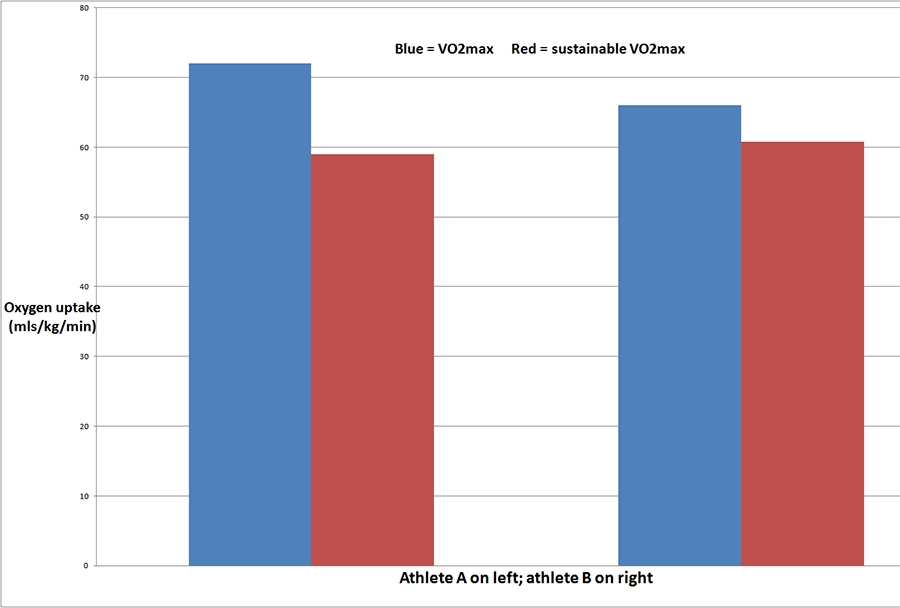
Although athlete A (left) has a higher VO2max (blue), his sustainable VO2 (red) is lower than athlete B’s (right).
The role of efficiency
The problem is that all other things aren’t always equal. So while MLSS is a good measure of endurance performance, it’s not enough. Another factor that needs to be taken into consideration is muscular efficiency. Muscles that work very efficiently are able to generate more propulsive force while requiring less energy (and therefore less oxygen). This internal type of efficiency is referred to as ‘muscle economy’. Economy refers to how efficient the muscles are (in terms of oxygen usage) at producing force during sub-maximal exercise (ie not flat out). The better the economy of your muscles during exercise, the less oxygen you need to use to propel yourself along at a given speed.Improving economy
If muscle economy measures how efficiently muscles work at sub-maximal work rates (ie not flat out), why is it important for maximising race performance I hear you ask? Well, studies show unequivocally that elite athletes have much higher levels of muscle economy than their amateur or recreational counterparts. In other word – muscle economy and high levels of endurance go hand in hand.One study of collegiate cross-country team members discovered that just two factors – maximum aerobic capacity (VO2max) and running economy - could account for 92% of the variance in performance during an 8000m race(4). Also, running economy, like VO2max, has been used to estimate marathon pace in elite runners(5).
In another study, researchers compared elite Eritrean runners with elite Spanish runners(6). Although both groups had very similar maximum aerobic capacities, the researchers were mystified as to why the performances of the Eritrean runners were consistently better than those of the Spaniards. Testing on both groups revealed that the key physiological difference was the exceptional running economy of the African runners; at 21kmh (13.0mph), the Eritreans needed to consume just 65.9mls of oxygen per kilo per kilometre - compared with 74.8mls of oxygen for the Spanish runners (see figure 2)!
Figure 2: Oxygen consumption per kilo per kilometre at 21kmh
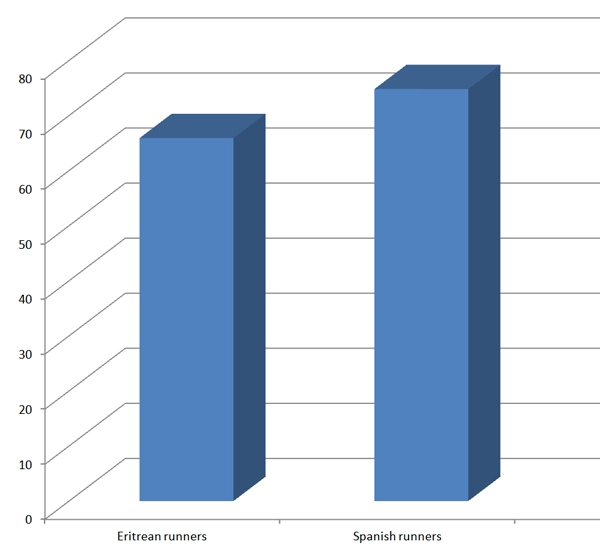
The Eritrean runners’ superior running economy meant they needed 13.5% less oxygen per kilo of body weight to maintain a marathon pace. This explained much of their performance advantage over their Spanish counterparts.
But you don’t have to be an elite athlete to experience the benefits of improved muscle economy. Even an averagely fit recreational sportive rider can reap the benefits of improved muscle economy. For example, a 4% gain in economy would mean that over a 100-mile event he/she would cover the distance around quarter of an hour faster for exactly the same effort!
Comparing economies
One question that is often asked is how specific muscle economy is. In other words, do runners need to run to improve running economy or can other endurance exercise types such as cycling, rowing etc be used? Likewise, can cycling economy only be achieved through cycling, or do other activities also boost it? The consensus of scientific opinion to date has been that (most like due to the greater skill and coordination required) running economy can be improved with running-specific training, while the improvement of cycling economy with cycling-specific training is less predictable. And now a recently published study adds some meat to the bone.In this study, scientists compared the running and cycling economy in three groups of athletes: runners, cyclists, and triathletes(7). To do this, the researchers recruited ten runners, nine cyclists and nine triathletes, all of whom underwent testing for their running economy (at 12kmh) and also their cycling economy (at 200 watts).
During the testing, the subjects’ levels of oxygen consumption and carbon dioxide production were measured. This enabled the researchers to calculate gross metabolic rate (ie actual energy expenditure in the muscles). Higher levels of energy production in the muscles for a given power/speed of locomotion indicates poorer muscle economy. This is analogous to a gas-guzzling car and a fuel-efficient car; the former needs to burn more fuel just to maintain a given speed and so has poorer efficiency.
The results were surprising; the runners had better running economy than the cyclists (917 watts of actual energy consumption for runners vs. 1111 watts for cyclists – see figure 3). Remember that lower energy expenditure to maintain a given power/speed indicates BETTER economy. The triathletes meanwhile had intermediate running economy values at 1004 watts. So far, this is what you might expect (given that cyclists don’t generally run as part of their training and runners only run in their training.
Figure 3: Absolute energy expenditure required to maintain 12kmh on the treadmill
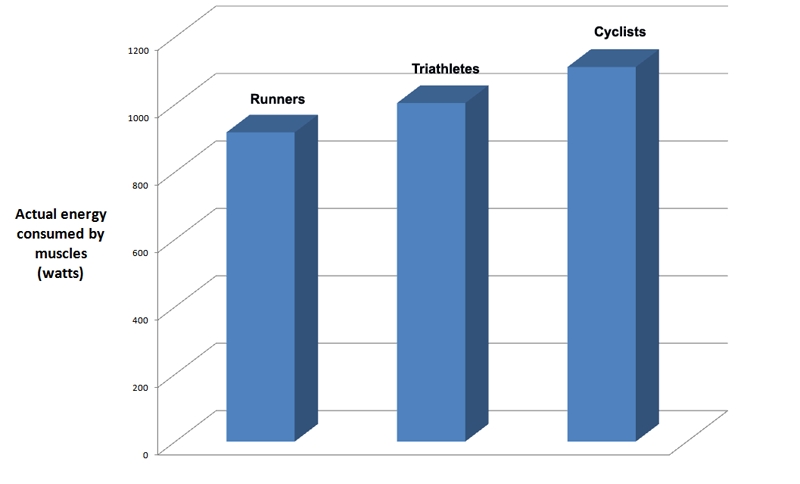
The really interesting part however is that the cycling economy figures for the three groups were very similar, with the runners needing 945 watts to sustain 200 watts on the bike, the triathletes needing 979 watts while the cyclists needed 982 watts. Indeed, once again, it was the runners who had the lowest absolute energy expenditure (although not so much lower that it was deemed to be statistically significant) even though you might expect the cyclists to be the most efficient. In plain English, the runners were equally as efficient as the cyclists on the bike while pedalling at 200 watts – even though they had no background in cycling training!
Implications for athletes
What this study demonstrates is that in this group of athletes at least, running economy was affected by running-specific training. Runners (and to a lesser extent) triathletes who run as part of their training exhibited significantly better levels of economy than cyclists. Conversely, cycling economy did NOT seem to be a function of prior cycling training. And while this was a relatively small scale study, these findings do seem to fit with previous thinking on this topic. But why does this matter?*First-time multi-sport running/cycling athletes such as triathletes and biathletes - the research suggests that where developing running economy is important (eg for events that include a long running segment), it’s crucial to accumulate some decent running mileage beforehand in order to develop running economy. For cyclists trying their hand at a biathlon for example, the need to devote a decent proportion of time to some running training is paramount. However, runners moving into biathlon may not need to add in too much cycling prior to competing as cycling economy will likely be pretty good to begin with.
*Triathlete training programmes - this research also has implications for triathletes. In many events, the bike leg is much longer duration than the run leg. This has led some coaches to take a ‘bike-first’ approach – ie the main focus of training should be to build up miles in the saddle to become an efficient rider, with a minimal emphasis on running. However, the results above suggest that triathletes – especially those from non-running backgrounds - need to consider incorporating enough running into their training programme to adequately develop good running economy.
*Cyclists – if you’re a cyclist you might be feeling a little miffed that hour after hour in the saddle doesn’t seem to appear to build cycling economy in any kind of specific way. But fear not because good research suggests that regular lower body strength training can and does increase cycling economy, which will mean less oxygen and less effort to sustain a given power output(8-11). . See panel below for an outline of the kind of strength work required.
Key principles of strength training for cyclists
- Strength train once or twice a week – no more.
- Keep strength sessions short but fairly intense (quality rules over quantity); don’t waste energy by performing endless sets of exercise (save as much energy as you can for the bike!).
- Choose 4-5 lower body strength exercises that involve cycling muscles (eg squats, leg press, lunges, glute machine, calf raises, leg curls etc.).
- Sets should consist of fairly high intensity, low volume (4-8 reps) reps with the resistance/weight adjusted to not quite lead to failure at the end of the set. Perform no more than 3 sets per muscle group with a rest of 2-3 minutes between each set.
- Maintain good form at all times.
- If you’re new to strength training, build into any programme gently to avoid post exercise muscle soreness;
- Eliminate strength training during the week immediately preceding an important race or sportive as part of your taper.
- If in doubt, consult a qualified strength and conditioning coach before commencing a strength programme.
References
- Med Sci Sports Exerc. 2001;33(12):2089–2097
- Med Sci Sports Exerc. 2005;37(10):1734–1740
- Eur J Appl Physiol. 2003;89(1):95–99
- J Sports Med Phys Fitness. 1991 Sep; 31(3):345-50
- J Physiol. 2008 Jan 1; 586(1):35-44
- Appl Physiol Nutr Metab. 2006 Oct;31(5):530-40
- Eur J Appl Physiol. 2018 Jul;118(7):1331-1338
- J Strength Cond Res. 2005 Nov;19(4):826-30
- J Strength Cond Res. 2007 Feb;21(1):289-95
- J Strength Cond Res. 2010 Aug;24(8):2157-65
- Scand J Med Sci Sports. 2011 Apr;21(2):250-9
Newsletter Sign Up
Testimonials
Dr. Alexandra Fandetti-Robin, Back & Body Chiropractic
Elspeth Cowell MSCh DpodM SRCh HCPC reg
William Hunter, Nuffield Health
Newsletter Sign Up
Coaches Testimonials
Dr. Alexandra Fandetti-Robin, Back & Body Chiropractic
Elspeth Cowell MSCh DpodM SRCh HCPC reg
William Hunter, Nuffield Health
Keep up with latest sports science research and apply it to maximize performance
Today you have the chance to join a group of athletes, and sports coaches/trainers who all have something special in common...
They use the latest research to improve performance for themselves and their clients - both athletes and sports teams - with help from global specialists in the fields of sports science, sports medicine and sports psychology.
They do this by reading Sports Performance Bulletin, an easy-to-digest but serious-minded journal dedicated to high performance sports. SPB offers a wealth of information and insight into the latest research, in an easily-accessible and understood format, along with a wealth of practical recommendations.
*includes 3 coaching manuals
Get Inspired
All the latest techniques and approaches
Sports Performance Bulletin helps dedicated endurance athletes improve their performance. Sense-checking the latest sports science research, and sourcing evidence and case studies to support findings, Sports Performance Bulletin turns proven insights into easily digestible practical advice. Supporting athletes, coaches and professionals who wish to ensure their guidance and programmes are kept right up to date and based on credible science.
